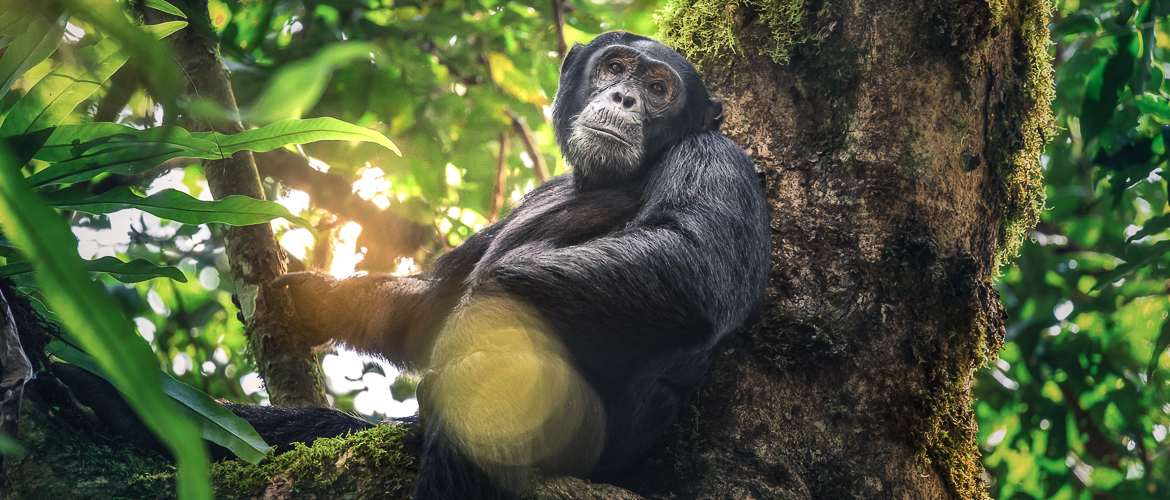
Chimpanzee Trekking Uganda: 21 Things to Know
Chimpanzee trekking in Uganda is one of the exciting activities that will turn your Uganda safari into an experience of a lifetime. Did you know that Chimpanzees are our closest genetic relatives, sharing over 98% of our DNA? They are native to Africa and can be found in the tropical forests and savannah across equatorial Africa. There are around 300,000 chimpanzees left. Tourists are able to observe them in their natural habitat, for instance in Kibale Forest Uganda: one of Africa’s most important primate sanctuaries. Along with Gorilla trekking, this is without a doubt one of the best things to do in Uganda. In this chimp article, I will share 21 things you need to know about Chimpanzee Trekking Uganda:
1. The Chimpanzee is a Threatened Great Ape species
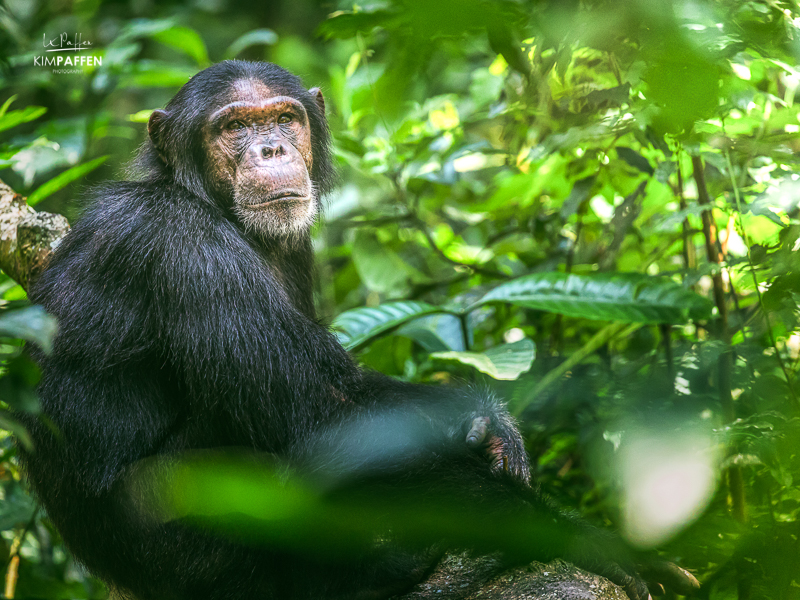
Africa’s chimpanzees (Pan troglodytes) are great apes (not monkeys) living in communities of up to 150 members. These members are divided into subgroups of 15-80 chimps directed by an alpha male. The other three types of ‘great apes’ are bonobos, gorillas, and orangutans. Chimps are a critically endangered species. It’s estimated that only 172.000-300.000 chimpanzees are remaining in the wild according to The IUCN Red List of threatened species.
The average height of an adult chimpanzee is around 150 cm and they weigh between 35–70 kg. Females weigh between 26-50 kg. The life expectancy of a chimpanzee is at 40 years however that for those living in captivity can extend up to 60 years.
Thanks to animal researchers and chimp experts like Jane Goodall, you can find a lot more information about chimpanzees.
2. The Best Places to see Chimpanzees in Africa
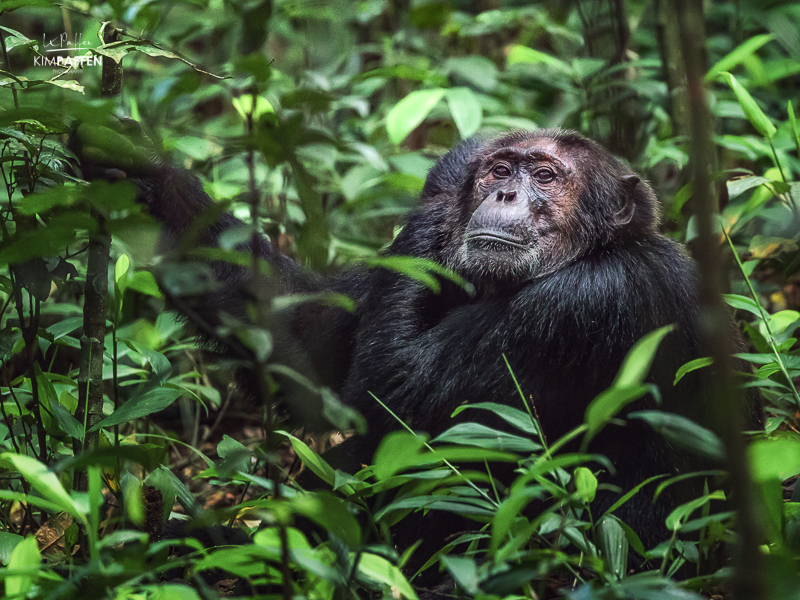
For those who are still wondering is there are chimpanzees in Africa, there are up to 300.000 chimpanzees left in Western and Central Africa. Tracking them in their natural habitat is a rare and rewarding opportunity. Chimpanzees are native to the grassland, bush forest, and savannah of Africa. However, there are only a few places where you can find them in the wild. Chimpanzees in the wild can be found in 21 African countries, including Uganda.
The best countries to see chimpanzees as travelers to Africa are Rwanda, (Western) Tanzania, and Uganda. Apart from these countries, chimpanzees also live in countries like Senegal and Congo. However, these primate destinations are less approachable for African tourism and there, chimpanzees are not used to humans.
The Best Places for Chimpanzee Trekking seem to be:
- Mahale Mountains National Park in Tanzania
- Nyungwe National Park in Rwanda
- Kibale Forest National Park in Uganda
- Budongo Forest in Uganda
Most of the chimps in these areas are well habituated, which means they are used to human beings around them in their natural habitat. The Uganda Chimp Tours are more affordable than Rwanda and Uganda is the only place to opt for a Chimpanzee Habituation Experience. Mahale Mountains National Park in Tanzania offers the largest chimpanzee population and it is the only place where chimpanzees and lions coexist. You have to explore the park on foot because there are no roads or other infrastructure within the park boundaries. The only way to this remote park is via a boat.
In conclusion, Uganda is the best place to see Chimpanzees in Africa. Uganda also has the most places to spot Chimpanzees with a high chance of seeing them. The chance of seeing Chimpanzees in Rwanda's Nyungwe National Park, are lower compared to Uganda.
3. Places to see Chimpanzees in Uganda
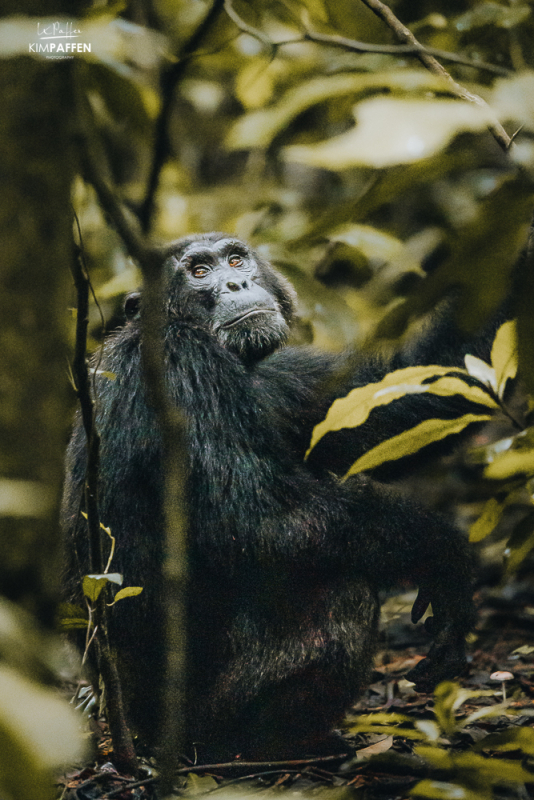
Uganda has around 5000 chimpanzees spread over five main chimpanzee destinations in Uganda, namely:
- Kibale Forest National Park
- Budongo Forest Reserve (part of the largest wildlife conservation area in Murchison Falls National Park)
- Kyambura Gorge (Queen Elizabeth National Park)
- Kalinzu Forest
- Toro (Semliki Wildlife Reserve)
In addition, two other options to see chimpanzees in Uganda are the Ngamba Island Chimpanzee Sanctuary and the Uganda Wildlife Conservation Education Centre (UWEC). However, the chimpanzees living there are orphaned chimps rescued from various places in Uganda. You can book a Chimpanzee tour directly through their site or ask your Uganda Tour operator to make a reservation.
4. Chimpanzee Trekking in Kibale Forest National Park
The Kibale Forest National Park in Uganda is the leading Chimpanzee destination in East Africa. This is also the place where we participated in the Chimpanzee habituation experience on our trip to Uganda. This jungle rainforest is home to about 30% of the Uganda Chimpanzee population, to nearly 1500 chimpanzees.
Kibale National Park is located in the Western part of Uganda in the district of Kabarole, about 350 km (5-hour drive) from Kampala. The park is home to 325 different bird species and offers twelve other different species of primates in addition to the chimps, which is the highest number and diversity of primates in entire Africa. That’s why Kibale Forest is also called ‘the primate capital of the world‘.
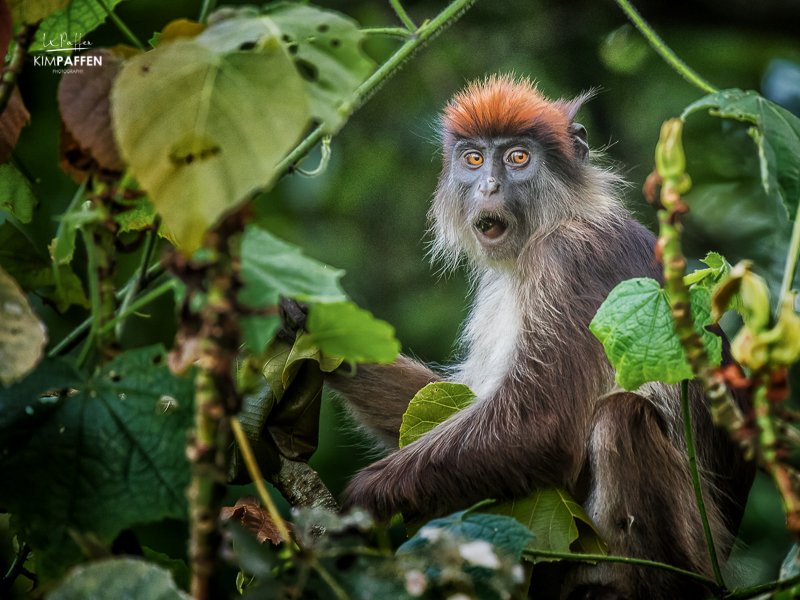
Other primates that can be found in Kibale are for example East Africa’s biggest population of the endangered red colobus monkeys, the black & white colobus, red-tailed monkeys, the uncommon L’Hoest’s monkeys, and the grey-cheeked mangabeys. Kibale Forest Uganda is also home to forest elephants and forest buffaloes, but they are rarely seen.
We joined the chimp habituation experience in Kibale Forest Uganda and I loved it! No wonder people from around the world travel to this leading Chimpanzee destination to visit our larger cousins.
One of the main reasons for us to see chimpanzees in Kibale National Park was because it’s the only place in Uganda for chimpanzee habituation experience where visitors can spend the whole day following a group of chimpanzees. If you would love to see both chimps and the endangered mountain gorillas, traveling to Uganda is your best choice.
5. What is a Chimpanzee Trekking?
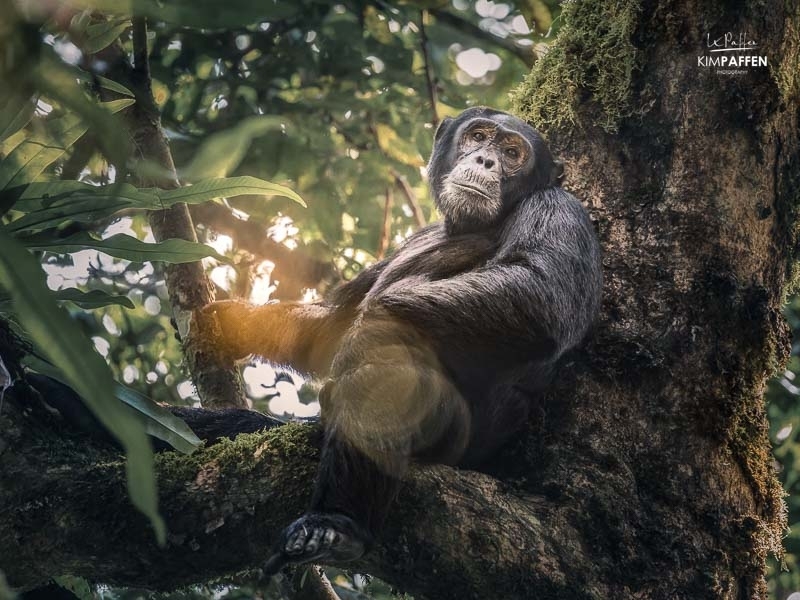
A chimpanzee trekking is a walk or hike with a professional guide, through the natural habitat of the chimpanzees, looking for a habituated chimp family. Once you reach them, you are allowed to stay near them and watch their daily living for a maximum of one hour. Because habituated chimpanzees are familiar with human presence, they will not runoff. Depending on the time and the activity they are doing, you can see them play, feed, or swing to different trees.
6. Chimpanzee Habituation Experience

The chimpanzee habituation experience is a whole day activity, where you take part in the process of making wild primates habituated, meaning they get used to people around them. During this activity, a professional guide takes you through the natural habitat of the chimpanzees and you will spend the entire day near a family of chimpanzees. You get the chance to be with chimpanzees during their daily activities like searching for food, grooming, playing, and making nests for the night. You will learn more about the process of tracking and monitoring the chimps as well as how they are habituated. Kibale Forest in Uganda is the only place to join this Chimpanzee Habituation activity.
7. Aim for an average fitness level for chimpanzee trekking
Great news, you don’t have to be very fit to see chimps, but is it pleasant if you have an average level of physical condition. If you’re not in a good condition, you have to rely on your determination to see the Kibale chimps. Chimpanzees are active animals and depending on the time of the day and their activity, they will move which means you move too. All participants will be divided into groups to visit different families. Some families stay near one of the starting points and others far, which means you have to hike longer distances through the dense forest.
8. Best Time to See Chimps in the Wild
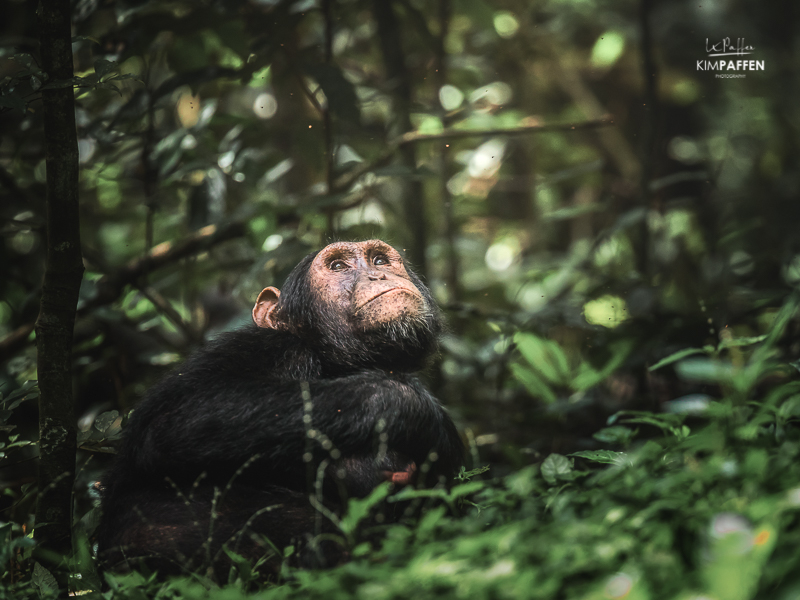
Both Uganda Chimpanzee activities can be done throughout the year. There is no best time for Chimpanzee Trekking to get ‘better sightings’. Dry seasons in Uganda are from June to August and from December to February. In these months, you have more chance of drier weather, but tourism numbers will be higher. Do not forget you’re trekking a rainforest, so it’s likely to get wet anyway. Don’t worry too much about the time of the year to track chimpanzees. Just make sure to schedule it in your Uganda travel itinerary and keep in mind that March, April, and November are less crowded.
9. The Price of Chimpanzee Trekking in Uganda
To see the Uganda Chimpanzees, you first need to buy a trekking permit. So, what is the price of Chimpanzee Trekking in Uganda? In Kibale Forest National Park, the permit for a chimpanzee habituation experience costs 300 USD, and the permit for a chimpanzee trekking costs 250 USD (rates per July 2024). In Kyambura Gorge, the price of a chimpanzee permit is 100 USD. These rates include a guide fee and the entrance fee. The Uganda Wildlife Authority, UWA, reinvests 20% of the permit fees into the local communities that border the parks. This organization also leads regular education programs highlighting the benefits and importance of Chimpanzee conservation.
Prices of chimpanzee trekking permits in other parks may vary. To see the current rates, check the website of the Uganda Wildlife Authority. In addition, there are transport costs, lodging, and meals. You can also book a tour with a (local) tour operator that covers all costs. Optionally, you can hire a porter to help you carry your stuff during the hike.
10. You Need a Chimpanzee Trekking Permit to See Primates in the Wild
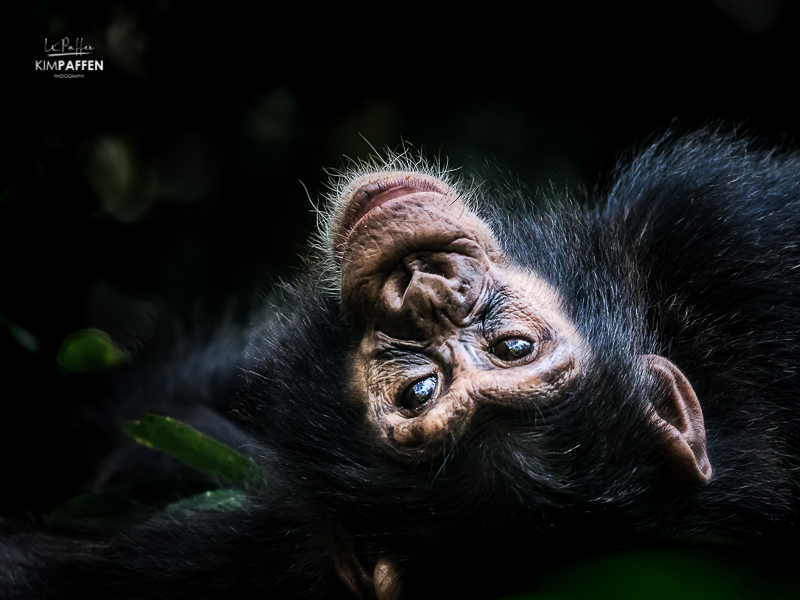
Buy chimpanzee trekking permits well in advance, especially in the high season (June to September). For the well-being of the Kibale chimps, there is a limited number of visitors allowed per day. I highly recommend buying your permit directly when you choose to add this activity to your Uganda travel itinerary.
Where to get a Chimpanzee Trekking Permit in Uganda?
The permits are issued by UWA which markets them through Uganda Tour Operators to the public. Therefore it’s best to book your Kibale Forest chimpanzee trekking permit (or a trekking tour) with an operator that is a member of the Association of Uganda Tour Operators.
11. Chimpanzee Trekking in Uganda is Safe
A chimpanzee experience in Uganda is perfectly safe. Uganda is a safe country for tourists and chimp trekking and habituation experiences are a valuable source of income, so there are high-security levels to maintain the safety of tourists and the chimpanzees. You don't have to worry about chimpanzee attacks as long as you listen to your guide and follow the park rules of the Uganda Wildlife Authority (see number 19 of things to know for tracking chimpanzees in Uganda).
And yes, there are a few disturbing cases in which chimpanzees attacked Ugandan people, and Ugandan families killed chimps, mostly because of crop loss. The primates had been coming closer throughout Kayamajaka village, searching for food, ripping bananas from the trees, and grabbing mangos. In Uganda, these primates are protected by law, meaning that it's illegal to hunt or kill chimps.
12. Not Everyone Can Participate in Chimpanzee Trekking in Uganda
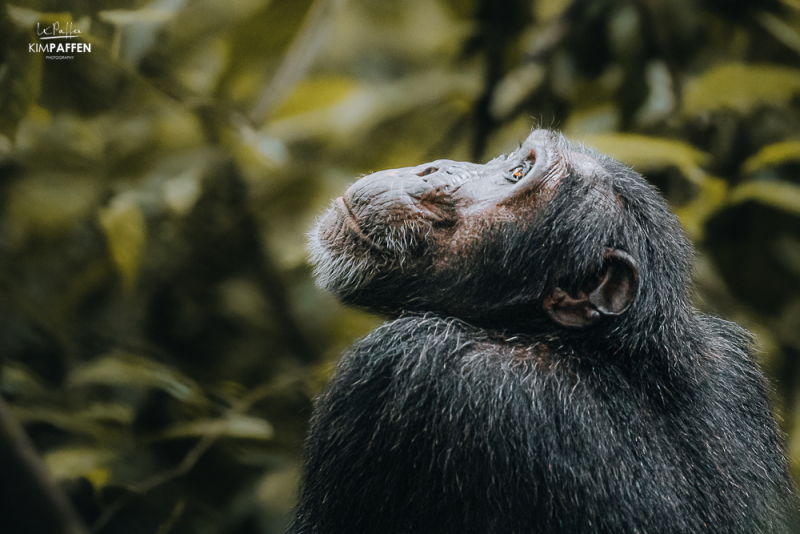
Not everyone can participate in chimp trekking or habituation in Uganda. You must be aged 12 or over and in good physical and mental condition. To maintain the health (and safety) of the chimpanzee, you are not allowed to join the activity if you are sick, because chimpanzees are susceptible to many of the viruses that affect humans. There is also a limited amount of people that can visit the chimps and the time to be near them is also limited. Tracking groups are then split into six people, seven including the ranger.
13. The Chance of Seeing the Uganda Chimpanzees are over 95%
However, chimps are wild animals, the chances of spotting them are almost certain. In Kibale National Park, chances are over 95% which makes it the most popular destination for chimp trekking in Uganda and East Africa. The ranger leads the visitors to a part of the forest where the chimps are last spotted. From there they continue their way to find the group of chimps. If you are tracking for a whole day and eventually failed to see the chimpanzees in Kibale Forest, you can reschedule the permit to the following day in case there are available time slots. If this is not possible, you might get a refund of 50% of the permit value.
14. Hire a Porter on your Uganda Chimp Trekking
![]()
You have the possibility to hire a porter on your Uganda chimpanzee trekking for 15 USD. This porter will carry your bag, stays with you during the chimpanzee safari, and helps you steady your balance if necessary. Although you might be in doubt if it is necessary to hire a porter, I would highly recommend doing so. After a while, your bag will become heavier during the track through the forest. You have to carry enough water, a packed lunch, energy bars, a rain jacket, and probably camera equipment. After (sometimes a few) hours of trekking, you will be thankful someone else is carrying your bag. But even more important, the best reason to hire a porter on your primate trekking is that you support the local community by doing so. The porters are mostly students or locals who earn some extra with it.
15. Chimp Experience in Kibale Forest: What to expect?
Kibale Forest National Park in Uganda is the only place in Uganda where you can choose between chimp tracking and chimpanzee habituation experience. Although, these activities are different, a lot of factors are similar. In short, both experiences start with the dividing of participants into small groups followed by a briefing. After this briefing with information and rules, you will meet your ranger who is armed in case of emergencies. Furthermore, free walking sticks are provided to keep your balance. Next, you will walk or drive to the starting point near the place where the chimps were last spotted.
From here, the ranger leads you through the forest and you will be listening for the chimp cries in the trees. Once you hear them, you really feel that excitement of finally seeing the chimpanzees in the wild. Immediately, you will head in the direction of the sounds and finally, you’re about the stand face to face with chimpanzees.
If you participate in a chimp trekking in Uganda, this is the moment when the 1 hour of staying near the chimps begins. When you participate in the Kibale Habituation Experience, you will follow the chimps and their trails till they make up their nests for the night (in the late afternoon).
After this wonderful primate safari experience, you head back to the starting point, extremely satisfied of spending time with these endangered great ape species. Meeting our closest genetic relatives is an experience you will never forget.
16. How to Prepare for a Uganda Chimpanzee Trekking?
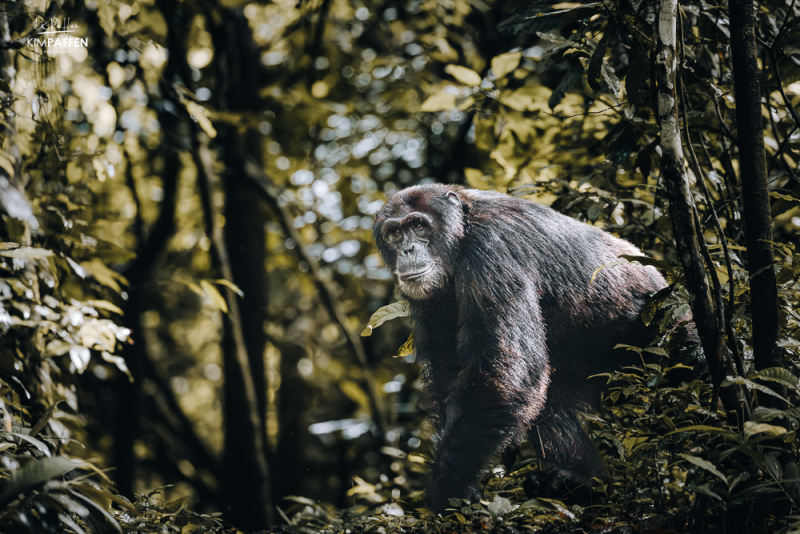
Preparing yourself for trekking through the forest to meet the chimpanzees of Uganda is a must. Make sure you are healthy, wear the right clothes and pack lunch and enough water. Knowing what to expect is one of the most important aspects prior to seeing the chimps. On the whole, be respectful to the animals, the environment, the staff, and visitors. Listen carefully to the rules, and stick to them. Read more about what to bring, what to wear and about the rules in the forest.
17. Complete list of what to pack for chimpanzee trekking in Uganda
It’s good to know what to bring for the chimp trekking in Uganda or habituation experience:
- Bring enough water, since you can’t buy water during the trekking
- Packed lunch and optionally energy bars as you will have your lunch inside the forest
- Biodegradable insect repellant and sunscreen
- Wet wipes or a small microfibre towel for rinsing hands and face
- Mini first-aid kit with antiseptic and plasters
- Camera equipment and/or your smartphone
- Rain sleeve to protect your camera
- Rain jacket
- Comfortable layered clothes.
18. What to wear on a Chimp Trekking in Uganda?
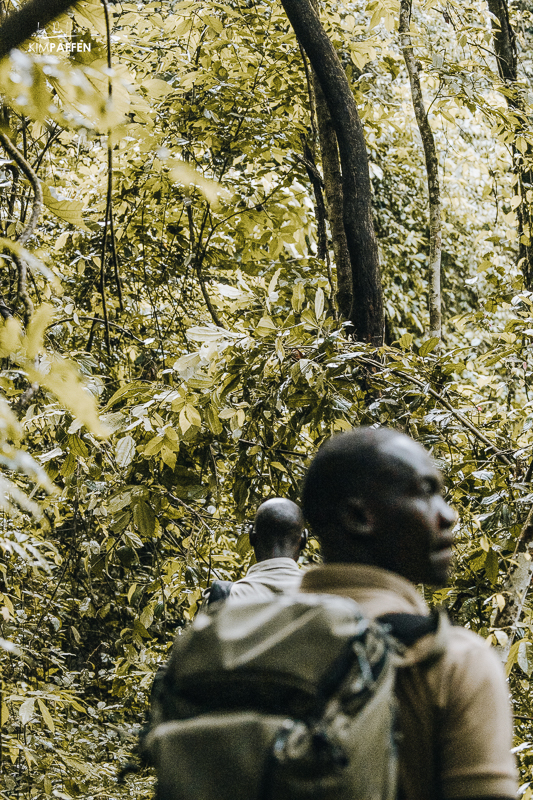
Here’s a list of tips on how to dress for a chimpanzee trekking in Uganda:
- Dress in layered clothes with natural colors in cool cotton or moisture-wicking fibers
- Wear long trousers and long-sleeved shirts to protect your body from bugs and scratches
- Wear water-resistant, comfortable walking/hiking shoes
- Pack gaiters to keep mud, sand, or water out of your shoes. The larger ones will keep the bottoms of your trousers dry. In fact, I wore gaiters on both chimp and gorilla trekking and was quite happy with it
- Put a rain jacket in your daypack
- Optionally a hat and/or scarf
- Pack gardening gloves to protect your hands by grabbing the branches for support. To be sure, I took them with me in my daypack but in the end, I didn’t use them
- Do NOT wear animal prints or military camouflage designs.
19. Rules when visiting chimpanzees in Uganda
To protect your safety and the safety of the chimps, there are some Uganda park rules and regulations you have to follow:
- Only enter the forest if you are healthy
- The minimum age for tracking is 12 years
- Do not eat near the Chimps
- Do not leave litter in the forest
- If you need to urinate or defecate, bury your waste in a hole (30 cm deep) along with any toilet paper
- Try to keep as quiet as possible in the forest. That way you will see more wildlife
- Do not mimic Chimpanzees’ vocalization (you don’t know what you might communicate)
- Keep 8 meters (25 feet) distance from the chimpanzees
- Do not chase the Chimpanzees
- Do not use flash photography and be prepared to photograph in darker conditions (low aperture and high ISO).
20. Photographing Chimpanzees in Uganda is Not Easy
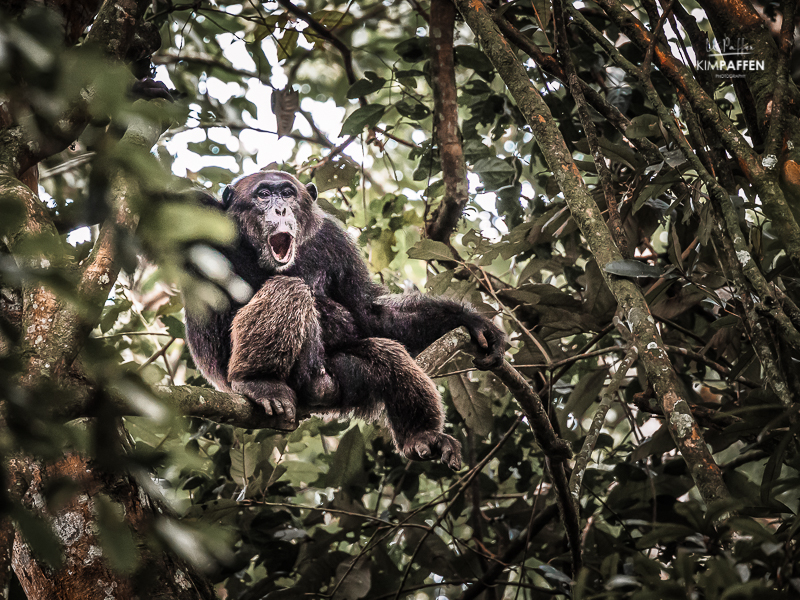
Chimps move fast through the forest, so I wouldn't say it's easy to photograph chimpanzees in Uganda. Especially in Kibale Forest, these great apes are really hard to keep up with as they swing around through the trees. Note that the chimp groups part of the habituating experience are only partially habituated, meaning it’s even more difficult to photograph chimpanzees on the habituation experience in Uganda.
When taking photos of the chimpanzees, you can't use your flash! Since you’re inside the forest there will be less light, so it’s recommended to have a camera that can perform with high ISO and low aperture. Whenever I travel to Uganda to track Chimpanzees in the wild, I bring two camera bodies and several lenses as part of my camera gear.
21. You can contribute to Chimpanzee Conservation in Uganda
By visiting the chimpanzees in Uganda, you are contributing to their conservation. To clarify, the population of wild chimpanzees has dropped dramatically in the last years (90% in the past twenty years). In West and Central Africa, there is still a lot of human encroachment on chimpanzee habitats and hunting of chimpanzees.
The UWA (Uganda Wildlife Authority) reinvests 20% percent of the permit fees into the local communities that border the park. In addition, they offer education programs that highlight the benefits and importance of conservation. Contributing to the conservation of chimpanzees in Uganda is extremely important. Further, The Jane Goodall Foundation has played a major role in the overall conservation.
By visiting the chimps in Uganda you will proudly contribute to chimpanzee conservation. A great way to travel responsibly and give back to nature and the community. A chimpanzee experience has to be part of your Uganda itinerary, you won’t regret it.
RELATED: Learn how to be a responsible traveler and give back to nature, wildlife, and the communities.
Uganda Chimpanzee Safari: Conclusion
Chimpanzee Trekking in Uganda is an unforgettable experience to see our closest relative up-close. Booking a Chimpanzee Safari Tour with a local tour operator or booking a complete Uganda Safari Tour are the best ways to see the chimpanzees in Uganda.
Apart from the Chimpanzee safaris, like the Habituation Experience and the Chimpanzee tracking, Uganda has a lot more beautiful places to explore like Murchison Falls National Park, Kidepo National Park, Queen Elizabeth National Park, and the Source of the Nile. Uganda is a great safari destination to spot the Big Five safari animals and two great apes species, the Gorilla and Chimpanzee.
If you have further questions about traveling to Uganda, the chimp and gorilla trekking, or the chimp habituation experience, please leave a comment or get in touch. My Uganda Travel Guide and Africa Travel Guide also contain useful safari tips.

